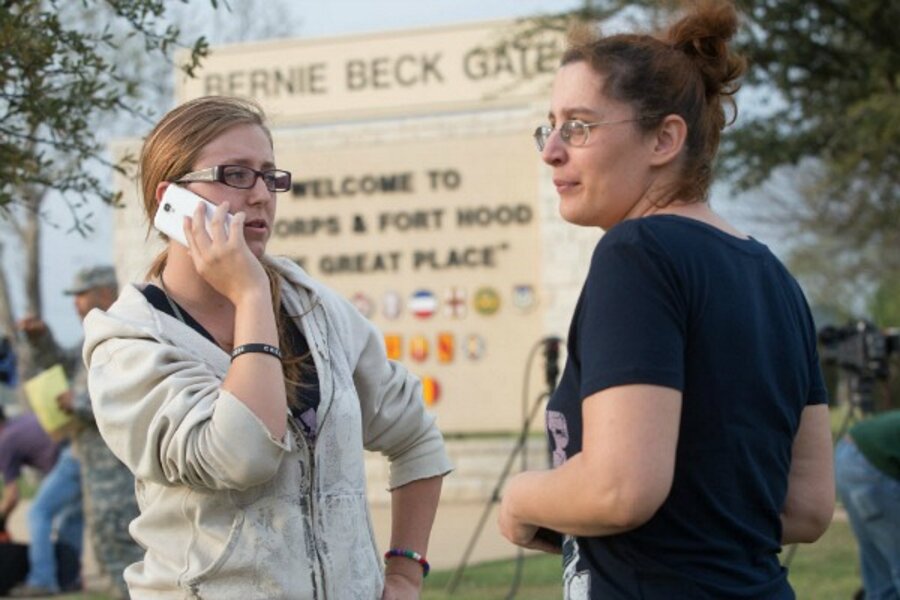Another Fort Hood shooting: Motive unclear, but 'jihad' ruled out
For a few hours Wednesday, the “fog of war” descended over Fort Hood, Texas, the scene in 2009 of the largest shooting incident on a military base in US history – one which seemed to have been repeated.
The number of attackers and victims remained unclear, as did the motive. For a while, press reports focused on an FBI warning Monday that an Army recruit “had publicly stated his intention to commit jihad, bidding farewell to his friends and making comments indicating his jihad was imminent.”
But soon after the shooting stopped, that scenario was quickly discounted, and a different picture emerged of the shooter, who had killed himself after killing three fellow soldiers and wounding 16 others.
As related by Lt. Gen. Mark A. Milley, Fort Hood’s commanding general, the shooter entered a building wearing his uniform and carrying a .45 caliber semi-automatic pistol.
He shot several people, drove his car to another building where more victims fell, then was confronted in a parking lot by a military policewoman when he shot and killed himself.
Lt. Gen. Milley did not identify the shooter, other than to confirm that he was a US Army soldier, married and with a family. Several news sources have identified him as Specialist Ivan A. Lopez, an enlisted man (E-4 rank).
Some reports have said the shooting was precipitated by some sort of dispute or workplace argument, but this has not been confirmed. Lt. Gen. Milley said that while “there is no indication that this incident is related to terrorism, we’re not ruling anything out.”
Lt. Gen. Milley said the shooter had served in Iraq in 2011. The soldier was being treated for anxiety and depression, Milley said, and was in the process of being diagnosed for post-traumatic stress disorder (PTSD). “He had behavior and mental health issues.”
The gun used in the attack had not been registered on base, and personnel there are not allowed to carry concealed weapons.
In many ways, Fort Hood is like a sprawling city. While military identification is required to enter the base, security measures are not as stringent as boarding an airliner, and it is possible for someone to drive on base with a concealed weapon.
Lt. Gen. Milley said that policy needs to be examined, although massive traffic backups could result.
Among other things, investigators will want to know if this deadly incident could have been predicted or prevented. That begins with a forensic investigation of computers the shooter may have had as well as interviews with those who knew him – including the medical professionals treating him.
For several hours Wednesday, Fort Hood was on lock-down as soldiers and their families were told to “shelter in place.” Outside the gate, spouses and others waited anxiously as they sought confirmation that their loved ones were safe.
All evening and night classes for the Central and Ft. Hood campuses of Central Texas College were canceled. Personnel and students were told to evacuate the college’s central campus in nearby Killeen, Texas.
Ft. Hood is the military facility where Major Nidal Malik Hasan, the former US Army psychiatrist and Medical Corps officer whose unit was preparing to deploy to Afghanistan, went on a shooting rampage in November, 2009, that killed 13 people and injured more than 30.
The attack ended when Maj. Hasan was shot in the back by Fort Hood police officers outside the building, which left him paralyzed from the waist down. Hasan is now on death row at the military prison at Fort Leavenworth in Kansas.
In a brief statement Wednesday, President Obama said, "They serve with valor, they serve with distinction and when they're at their home base, they need to feel safe," emphasizing that soldiers who have served in today’s war zones – many of them multiple times – deserve to feel secure when they’re home with their families between deployments.
"We don't yet know what happened tonight, but obviously that sense of safety has been broken once again," Mr. Obama said. “We’re going to get to the bottom of exactly what happened.”
After the 2009 Hasan shooting, the military tightened security at bases nationwide. Those measures included issuing security personnel long-barreled weapons, adding an insider-attack scenario to their training, and strengthening ties to local law enforcement. The military also joined an FBI intelligence-sharing program aimed at identifying terror threats.
In September, a former Navy man opened fire at the Washington Navy Yard, leaving at least 13 people dead, including the gunman. After that shooting, Defense Secretary Chuck Hagel ordered the Pentagon to review security at all U.S. defense installations worldwide and examine the granting of security clearances that allow access to them.
This report includes material from the Associated Press.






